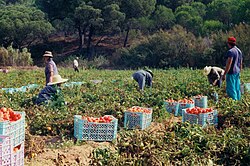Melides
| Melides | ||||||
|---|---|---|---|---|---|---|
|
||||||
| Basic data | ||||||
| Region : | Alentejo | |||||
| Sub-region : | Alentejo Littoral | |||||
| District : | Setubal | |||||
| Concelho : | Grândola | |||||
| Coordinates : | 38 ° 9 ′ N , 8 ° 44 ′ W | |||||
| Residents: | 1658 (as of June 30, 2011) | |||||
| Surface: | 155.16 km² (as of January 1, 2010) | |||||
| Population density : | 11 inhabitants per km² | |||||
Melides is a Portuguese municipality ( freguesia ) in the district of Grândola with an area of 155.2 km² and 1658 inhabitants (as of June 30, 2011). The village of Melides is about 8 km from the beach of the Atlantic Ocean and about 20 km from the district capital Grândola.
Melides has a well-preserved old village center with the small traditional church of S. Pedro from the 18th century. Melides, like the neighboring town of Vila Nova de Santo André, is known for its fishing and the sale of fresh fish in the small market hall in the center of the village. The old spring house of the Fonte dos Olhos is located in a depression at the entrance to the town . Here a small river emerges from a source, which supplies the region with fresh water even in midsummer. The river leads into a lagoon near the beach (Lagoa de Melides).
There are many summer houses around the village and in the surrounding mountains, which are mainly inhabited in the high season. There are several restaurants in Melides as well as various private holiday homes, two large campsites and guarded beaches at the estuary and in the Aberta Nova and Galé area .
history
In the vicinity of Meldides in Vale Figueira there is a Celtic monument Casas Velhas , which indicates that this area was settled by Celts as early as the Bronze Age and Stone Age 3000–4000 years ago. On September 26, 1895, the municipality of Melides passed from the district of Santiago do Cacém to Grândola and has remained there to this day.
Individual evidence
- ↑ www.ine.pt - indicator resident population by place of residence and sex; Decennial in the database of the Instituto Nacional de Estatística
- ↑ Overview of code assignments from Freguesias on epp.eurostat.ec.europa.eu
Web links
- Map of the Freguesia Melides at the Instituto Geográfico do Exército







